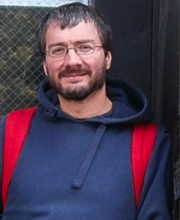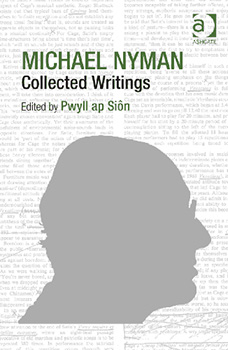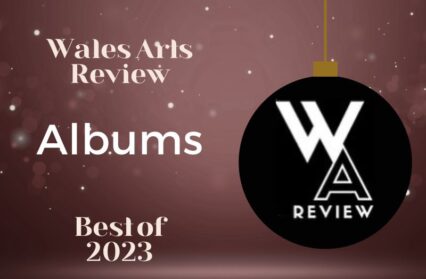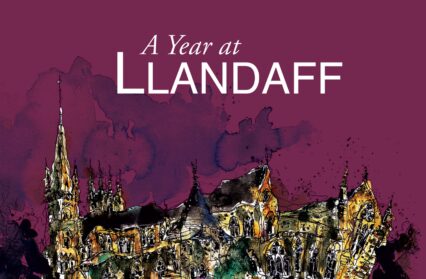
Michael Nyman: Collected Writings edited by Pwyll ap Siôn was published by Farnham: Ashgate, August 2013. Wales Arts Review is proud to publish four articles and an Introduction by Michael Nyman, selected from the book, together with an Introduction and Conclusion by Editor Pwyll ap Siôn (excerpted by permission).*
Introduction by Pwyll ap Siôn
 For over three decades Michael Nyman’s music has occupied a unique position in the late twentieth- and early twenty-first century. While many contemporary composers’ music has remained limited in reach, Nyman has connected to a much wider audience. His film scores, from the early Greenaway collaboration The Draughtsman’s Contract (1982) to the enormously successful The Piano (1993) have been matched by an equally active career composing standard orchestral, chamber and operatic music.
For over three decades Michael Nyman’s music has occupied a unique position in the late twentieth- and early twenty-first century. While many contemporary composers’ music has remained limited in reach, Nyman has connected to a much wider audience. His film scores, from the early Greenaway collaboration The Draughtsman’s Contract (1982) to the enormously successful The Piano (1993) have been matched by an equally active career composing standard orchestral, chamber and operatic music.
An important element in unlocking the key to Nyman’s success lies in his writings about music, which occupied him for over a decade from the late 1960s onwards. During this time he produced well over 100 articles, covering almost every conceivable musical style and genre – from the early music revival and the West’s interest in ‘world’ music to John Cage, minimalism and rock.
It is not so much the breadth and range that marks Nyman’s writings as important contributions to twentieth-century scholarship, however. Nyman’s writings are important because they initiated a number of landmark moments along the way. He was one of the first to critique the distinction between European avant-garde music and the American experimental movement – to tease out significant differences between Karlheinz Stockhausen on the one hand and Cage on the other. He was the first to coin the term ‘minimalism’ in relation to the music of (then relatively unknown) American composers Steve Reich, Terry Riley and Philip Glass. Nyman was also one of the first critics to seriously engage with the music of the English experimental tradition, to emphasize the importance Cornelius Cardew and the Scratch Orchestra. Soon after writing about these composers, Nyman realized how these elements could be brought together into a new vision for his own musical language, which was set in motion in the late 1970s and early 1980s.
Much of what transformed and defined Nyman’s musical character may be found within the pages of his Collected Writings. There is also much here to provoke and stimulate the minds of those interested in music outside the twentieth century – from Baroque music via Haydn and Berlioz to the symphonic works of Bruckner and Mahler. It is important to remember that Nyman’s training was very much in the classical tradition; he once stated that ‘I get all my musical kicks and ideas from the European symphonic tradition’. It is this classical sensibility – an ability to grasp, develop, transform and refine verbal and musical thoughts and ideas – that marks out Nyman’s writings as a significant contribution to music in the twentieth century.
Introduction by Michael Nyman

It all started in July 1968 with simple phone call from the writer and Kurt Weill scholar David Drew to ask me, a 24-year-old freelance musician with no writing experience, to review for The Spectator a single performance – French composer Olivier Messiaen’s Turangalîla-Symphonie – because the regular music critic was understandably not interested. The texts selected and reprinted in the Collected Writings present the written consequences of that phone call.
I spent the next 10 years freely chronicling what at the time and certainly in retrospect was a truly diverse musical culture of the late 1960s and 1970s. Firstly, there were the editors for whom I wrote – Nigel Lawson at The Spectator, Labour grandee Richard Crossman at the New Statesman and literary giant Karl Miller at The Listener. Secondly, I had direct contact with an imaginative group of arts page editors: Hilary Spurling at The Spectator (writer of an authoritative biography of French artist Henry Matisse) and Mary-Kay Wilmers at The Listener (now editor of the London Review of Books and author of her remarkable family history, The Eitingons). Since I lived on New Cavendish Street, a 10-minute walk away from The Listener offices in Langham Place, I would quite often get an urgent request from Mary-Kay to fill in for some non-delivering writer to cobble together one of the feature articles with sometimes only around 24 hours’ notice!
Thirdly, there were all the other music critics, who, apart from one or two (such as Dominic Gill) looked on my critical values with suspicion. The Nyman-the-Music-Critic ‘look’ was also wrong – 24-years old, balding but with wild hair and black David Hockney glasses, and not a suit or even a sports jacket in sight. But it was the sheer contradictory but inclusive diversity of music that I was inclined to (dis)cover on a weekly basis which diverged singularly from that of my colleagues.
And so, fourthly, my practice as a critic involved hanging out with the very composers whose work I was writing about. I more-or-less became Harrison Birtwistle’s amanuensis in the late 1960s – compiling the libretto for his opera Down by the Greenwood Side, writing detailed articles about his work, and editing his scores. But by 1970, when I signed the book contract with Studio Vista to write Experimental Music: Cage and Beyond, my allegiances had shifted from modernism to ‘experimental’ music: Cornelius Cardew, the Portsmouth Sinfonia, Christian Wolff, Earle Brown, La Monte Young, Terry Riley, Nam June Paik – and John Cage, obviously – all came rushing into my ‘observational’ critical life. And the consequences of this new allegiance were instant: I had pointed out in a Time Out preview of the London premiere of Stockhausen’s Stimmung in 1971 that the piece was very dependent on the work of La Monte Young, and just as I was leaving a party thrown by his manager to celebrate the premiere, Stockhausen approached me and said, ‘You are the person who has been spreading false information about my music!’
During this time I also first met Steve Reich, with whom I conducted his first European interview in 1970 and to whom I was even closer than to Birtwistle. My subsequent involvement with Reich’s work during my days as music critic was as agent for performances of his music in venues such as the Institute of the Contemporary Arts and the Hayward Gallery. But it was being a participant/performer in the English experimental musical culture that finally led to my transition from critic to composer. Cardew’s classes at Morley College, the Scratch Orchestra, the Portsmouth Sinfonia – these were all routes towards recovering my voice as a composer, initially with the Campiello Band, then with the Michael Nyman Band. And therein lie the two reasons why I gave up my career as music critic. The first, on principle, was that I felt it inadvisable, if not dangerous, to have to write about the music of my now composer colleagues; and, second, because I had run out of the ability to pass judgment, somehow. In a review of Granville Bantock’s choral symphony Vanity of Vanities for unaccompanied voices for The Listener, I was unable to make up my mind whether it was a great work, a good work, or a bad work. I realized it was time to draw a straight line and follow it …
Four articles selected from Michael Nyman: Collected Writings
‘Minimal Music’ (The Spectator, 11 October 1968)
Walking home from the Fugs’ concert, organised by the Middle Earth at the Roundhouse last week, I was shocked by the 4 a.m. silence – by its awesome superiority to a lot of modern music, and by its unfamiliarity. But I listened harder – having trained myself never to take things at ear-value – and heard a medium-pitch humming in my ears not unlike the buzzing of electric fences with which the controlling hand of man has added his audible presence to country silences. The buzzing was the only musical memory I had left of the warm-up group, the Spooky Tooth, whose amplification system, as is usual, acted as a physical conditioner: the amplified pulse of bass guitar and drums striking simultaneously through ear and floor, charging the frame with an obsessive sound transfusion.
Such crude physical involvement is, of course, disruptive in theory, habit-forming in practice. Yet the violent political message of the Fugs is embodied in gentle, nostalgic, even elegiac music, some of which would not be out of place in the Burl Ives Song Book. This scatological, crass, entertaining, unconfined and imaginative show was the climax of a fortnight’s off-the-beaten-circuit concerts, which had led me to cultivate a receptive mindlessness, rather than the more or less rational perceptivity that most forms of music require.
My journey to the underground has also led to the conclusion (not particularly new) that our existing concert halls may be adequate for the classics, but not for some types of new music which need a more theatrical setting. But there I was, in the Wigmore Hall of all places, absolutely mesmerised by Cornelius Cardew’s The Great Learning last week. This was the piece which caused a riot at this year’s Cheltenham Festival – taking into account the musical backwardness of the locals, the comparative sophistication of the London audiences and the gentle honesty of Cardew’s music, it is not surprising that this un-English outburst was not repeated. Cardew’s piece succeeded, where pop and chanting failed, in completely clearing the mind. And with very slender means – an opening concertante passage for massed stones; a long organ solo, brilliantly realised by Michael Chant, which created by the persistent prolongation of held notes very delicate tensions; finally an alteration of solos for any kind of whistling instrument (performers individually interpreting the hieroglyphics of the score), and a speaking group who intoned a beautiful short text of Confucius, recommending introspection and ‘watching with affection the way people grow’. The whole was as real as a drizzly afternoon, gradually eating away at our blinded and cluttered musical mentalities.
I also deduced a recipe for the successful ‘minimal-music’ happening from the entertainment presented by Charlotte Moorman and Nam June Paik at the ICA. Simple idea, straightforward structure, intellectual control, theatrical presence and intensity in presentation. These all contributed to Paik’s spellbinding performance of Springen by Christiansen, a hypnotic ten-minute piece which consisted of nothing but a series of parabolas traced by the fingers, arm and eyes of the performer in ever-widening arcs. First from middle C on the piano to top C, from top C to the C below middle C and so on, gradually taking in the whole stage which became an imaginary extension to the keyboard. The rest of the programme by this most famous American happening duo in the business was a celebration of the cello of Miss Moorman, who in one piece fought with it in a large blue bag with zippered orifices.
This kind of act, though it uses no words, is as inventive as the Fugs in flinging artistic insults (some rather old) at the audience. In one terrifying piece Miss Moorman listens to a recording of bombardment and responds by violently attacking her cello, as if to express the futility of art attempting to compete with the horror of the ‘real’ world. Yet the whole performance seemed curiously muted and polite. Perhaps the ICA was trying to ‘reach’ as large an audience as possible. Such compromises do not work.
‘John Cage in Paris’ (New Statesman, 6 November 1970, p. 617)
Europe’s first Musicircus, which took place in Paris last week, under the auspices of the Semaines Musicales Internationales de Paris, was, so we had been told, ‘under the direction of John Cage’. As I saw Cage taking the sounds (as one takes the air) in the vast circus in Les Halles, I asked him what instructions he had in fact given to the motley collection of assembled performers. None, he replied; he’d merely asked the organisers to get together as many things as possible. Did he consider the Musicircus to be his composition? No. (Pause.) ‘It’s more interesting than most of my compositions.’ He laughed, completely without affection, and just as he did so a student brass band struck up, out of nowhere, a heavy German-type march. Cage, surprised and charmed, applauded gleefully like a child given an unexpected but very special present.
Genuine simplicity, acceptance, even saintliness are the keys to understanding Cage’s music. He wants nothing to belong to him, which is why he turns the process of composition over to random methods, and the process of performance to the ability, understanding and creativity of the performer (an even more saintly and dangerous act). Each time a piece is performed it is made over again, from a state of nothingness, to a state of nothingness, leaving no remains from one realisation to another.
How does this match up with a Boulez, obsessed as he is with purely aesthetic justifications, with perfection and correctness and, by comparison with Cage, sterility – painstakingly sifting and scrutinising, year in, year out, the small residue of sounds he has, with acute sensitivity, dredged from the vast river of music?
Cage’s achievement could be seen not in terms of his compositions in themselves, but in the way they make us aware of the richness of the music inside the river, and of the richness of music inside us. His scores not only permit any sound, from any part of musical history, to be heard in them, but he has also introduced means to make audible sounds that were always ‘there’, but previously inaudible. In Cartridge Music (1960) he used, for the first time, amplification to liberate ‘sounds … too small to be heard’. And in Variations VII (1966) he used a multitude of receiving sets to pick up the inaudible sounds with which the air is filled.
How does this compare with Stockhausen’s position? He claims that ‘I am not writing my music, but merely transcribing the vibrations I receive’; but in Stockhausen’s case the transcriber becomes possessor, arranger, rearranger, so the sounds cease to be what they were – Cage tries to let them out of their cages of association and ‘meaning’ – and become nothing more or less than Stockhausen (this is the traditional role of the composer after all).
Cage, in the Théâtre de la Ville, could sit through the first performance of Song Books (Solos for Voice 3–92) done simultaneously with Concert for Piano and Orchestra and Rozart Mix, apparently oblivious to what was going on around him and could, among other things, produce on an amplified typewriter (as I saw later) the much-repeated phrase to the effect that the composer has no right to waste the time of an audience.
Stockhausen, on the other hand, during performances of his music sits in the centre of the action and, by using filters and potentiometers, censors, regulates, alters and structures the sounds he receives from the performers who have been ‘inspired’ by his word scores. As a further distinction from Cage, to whom the idea of improvement, progress and making symbolic connections is alien, take a work like Stockhausen’s Spiral, a package which comes without the material but with extensive rules for making and developing it in a complex formal scheme, and which carries the regulation that each time round the performer should begin again not from nothing but from where he left off last time. In the words of the master, he should ‘transcend the limitations of his technique’ etc.
But in a way it is not the German who is the antithesis to Cage (he has made every attempt to come to terms with Cage’s teachings) but some younger American composers who have themselves been liberated by Cage’s openhandedness. A most fascinating aesthetic reversal can be seen in the work of La Monte Young, who in 1960 wrote (29 times) a piece which instructed ‘Draw a line and follow it’. More recently he has developed a music of ‘privilege’, which consists of a continuous sound which grows from an almost imperceptible amount of material, which completely shuts out silence (Cage’s baby), which depends entirely on the personal taste of the composer and which can be performed only by Young and his close associates. For a performance Young needs a whole week in which to become accustomed to the vibrations (both senses) of the hall.
Cage’s music is similarly, though not so crucially, dependent for its success on who performs it, in what context, and in what atmosphere. It’s safe to say from the two-day crash course in Paris that the French do not understand Cage. Only one event – the slightest – was really ‘good Cage’ (a concept one senses rather than explains). That was Music for Carillon, which took place in the Mairie near the Louvre. This was a beautiful setting: a group of people standing about in a courtyard as dusk fell, listening to the most heavenly, barbaric music issuing from the bell tower, in perfect focus. The right focus is crucial to Cage performances, and the French managed to focus wrong at both ends of the telescope. Two piano pieces (performed along with, amongst other things, 45’ for a Speaker) were concerned with an almost Boulez-like sense of nervous activity, something which Cage has guarded against by stressing that the ‘notation may be read in any “focus”, as many or as few of its aspects as desired being acted upon’ (the idea of leaving notes out of Boulez …!). Cage didn’t seem to mind; he was content just to laugh at the jokes in 45’.
That’s one side of the automatism possible when misinterpreting Cage. The other occurred during Rozart Mix, which was more involved with making and putting on the tape loops than making them sound. Cage didn’t seem to notice. Nor did he mind that Cathy Berberian in Song Books used many old clichés of the avant-garde – such as onstage cookery – or that she added very little to the repertoire of gestures already known from her masterly readings of Aria. Nor did he seem to be perturbed by the way in which the soprano, Simone Rist, pandered to the liberal bourgeois taste of the audience by appearing on stage successively as a railway worker, riot cop and nun (each of which were duly and fatuously applauded).
Perhaps we should all learn from Cage’s Zen Buddhism that all these things do not matter and we should not allow ourselves to be disturbed by them – as we could also learn from how to accommodate the paradox of spending two days cooped up in concert halls listening to the music of a composer who has tried to remove himself from his music and his music from ‘culture’.
‘The Music of Steve Reich’ (Time Out, February 21–March 7 1971, p. 85)
At the ICA Gallery on 7 March [1971] Steve Reich introduces his Live/Electric music to England, where he is less well-known than Terry Riley and La Monte Young with whom he shares common ground. Like them he has gone back to the ritual sources of music, to the pulse and the drone, to the use of constants which Western Music lost with Culture. He has just returned from studying African drumming in Ghana though he is not interested in making his music sound ‘exotic’ or primitive or African (the sitar in rock trip). Like Riley he has used tape loops but not merely repetitively (though he did this to some extent in his collage scores for Bob Nelson’s Plastic Haircut and Oh dem Watermelons). Instead he sets identical loops against each other and lets them go gradually out of phase. Come Out is fantastic, a short spoken sentence beating against itself till the space fills out with an incredible number of micro-organisms beating in the air. Since 1966 he’s been applying this technique to live music and in Four Organs (which he and his group will play at the ICA) he takes an unvarying maracas pulse and subjects the notes of a simple chord (an E7th with a tonic on the top!) to a slow-motion process. As you become involved in the opening out of this chord you will experience an unexpected range of things: from sounds which seem to have been produced electronically to a musical prick-teasing as the bass root of the chord becomes more and more delayed.
Live/Electric music by Steve Reich, Sunday 7, 8pm. ICA, Nash House. Includes 1st performances of Phase Patterns and Four Organs (30p members and 40p guests)
‘Mexican Discovery’ (The Listener, 21 April 1977, pp. 520–21)
It is possible, of course, and for some very tempting, to treat this column as a means of confirming and publicising familiar opinions about what Radio 3 is renowned for, familiar music. For me, as must be obvious by now, writing this column only has any value when, hidden among the familiar acres, one discovers something new. A greater pleasure still when a new piece (new to me, that is, not necessarily new chronologically) gives one the opportunity to confirm what one had read about a previously unheard composer, but had found rather suspect – opinions overstated by special pleading. It happens rarely, but it did happen just before Easter with the music of the Mexican, Sylvestre Revueltas, whose tone poem Sensemaya (1938) was included in the intriguing programme presented by the Venezuelan National Symphony Orchestra, conducted by the tireless veteran Mexican, Carlos Chavez, whose Toccata for percussion was also played.
Chavez is known at least by name, perhaps by reputation, less likely by his music, as being, more or less, the founder of Mexican new music. Revueltas, who worked closely with Chavez (both were born in 1899), called him a composer ‘made out of iron who organised the music production and activity of Mexico’. Together, these two, and a small group of younger composers, in Revueltas’s own words ‘animated by the same impulse and by a great amount of destructive energy’, fought against the ‘ancestral apathy and darkness of the academic musicians. We cleaned, swept, and washed the old Conservatory that was crumbling down with tradition, moths and glorious sadness.’ In 1928, they founded the Orquesta Sinfonica de Mexico, introduced the music of Stravinsky, Debussy, Honegger, Milhaud and Varèse, which stirred up the ‘placid dreams of the ancient “professors” who were addicted to the old moths, and also of the public anaesthetised by the yearly Beethoven’, conducted by those ‘venerable consecrated maestros that tried to squeeze from the nine symphonies the total amount of musical literature’. (I make no apologies for quoting the words of Revueltas, since they carry the same conviction that his music appears to.)
I said earlier that I had been suspicious of the claims made on Revueltas’s behalf, not by Mexicans, but by Californian composers who might be accused of merely promoting ethnic and national musics neglected and downtrodden through European American cultural imperialism, of hero-worshipping a man who they never knew (he died in 1940) more for his social/political/creative identity than for his actual music. Certainly, the testimony of people who knew Revueltas is persuasive.
But the passionate, wild, concentration of Sensemaya has temporarily convinced me that admiration for the man is of a piece with admiration for his music. The compulsion of this tone poem derives not merely from its overt subject-matter (inspired by the verses of the Afro-Cuban poet Nicolas Guillen) which, according to one commentator, gives form to the ‘suffering of the Negro oppressed by centuries of misery’, but also because Revueltas, according to Paul Bowles, knew that the ‘bases of music’ were not in the Europeanised conservatoires, but in the ‘noises that accompany drunkenness and abandon. He had played in border bars and dives and movie houses in his youth. With this education his approach could only be healthy.’ And like many Latin-American artists and musicians, Revueltas was intensely political, not being able to detach himself from society and its problems as European and North American artists often find so easy.
His short creative life – he wrote all his music in the 1930s – conveniently fell into that brief era when popular, socialist realist or politically involved music had replaced (rather than developed out of) the experimentation of the later 1920s (similar things are happening today, as Cornelius Cardew’s musical position shows). Chavez, for instance, fascinated by modernism in the 1920s, turned out pieces with geometric titles like Poligonos, Exagonos, or physical ones like Energia and Espiral, while, in the Thirties, we find the Sinfonia Proletaria and the Obertura Republicana. I am far less impressed by Chavez’s music, if his 1942 Toccata for percussion is a good example. In fact, the strengths of Revueltas – the almost tangible physical abandon – emphasise the weakness of Chavez, with his emphasis on control, clarity and calculation. The Toccata, both rhythmically and texturally, is a cautious piece, as though Chavez was deliberately holding himself back, scrupulously unwilling to overexploit the character of skins, metal and wood.
More relevantly, on the strength of Sensemaya, Revueltas (to make a wild journalistic oversimplification) is a Varèse with passion, a human face.
Conclusion by Pwyll ap Siôn
Nyman’s diverse experiences during the time in which he was most active as critic – as musicologist, composer and performer – is reflected in his ability to talk about, and draw parallels between, a wide range of musical styles: from Berlioz to minimalism, from early music to modernism, or from folk music to Cage and the experimental movement. What ultimately motivated Nyman as a critic was the discovery of something new ‘hidden among the familiar acres’, and in many respects one of his main achievements as writer was to uncover and introduce new areas to new readers. However, when the act of writing music took over from the act of writing about it, Nyman’s days as critic were numbered. Having started to discover new ideas and techniques through composition rather than criticism, Nyman could place 10 years of listening, analysing and writing about the subject into the practice of forming and developing a musical language from his critical language.
Pwyll ap Siôn is Senior Lecturer in Music at Bangor University, Wales. His publications include The Music of Michael Nyman and Michael Nyman: Collected Writings. He is a composer and also writes regularly for Gramophone magazine.
*Excerpted by permission of the Publishers from ‘Introduction’, in Michael Nyman: Collected Writings edited by Pwyll ap Siôn (Farnham: Ashgate, 2013), pp. 1–26. Copyright © 2013
This permission does not include the right to grant others permission to photocopy or otherwise reproduce this material except for versions made by non-profit organisations for use by the blind or handicapped persons. For any other use permission would need to be sought from Ashgate. Please also note, Ashgate cannot grant permission for the use of material from third-parties.
Banner illustration by Dean Lewis










